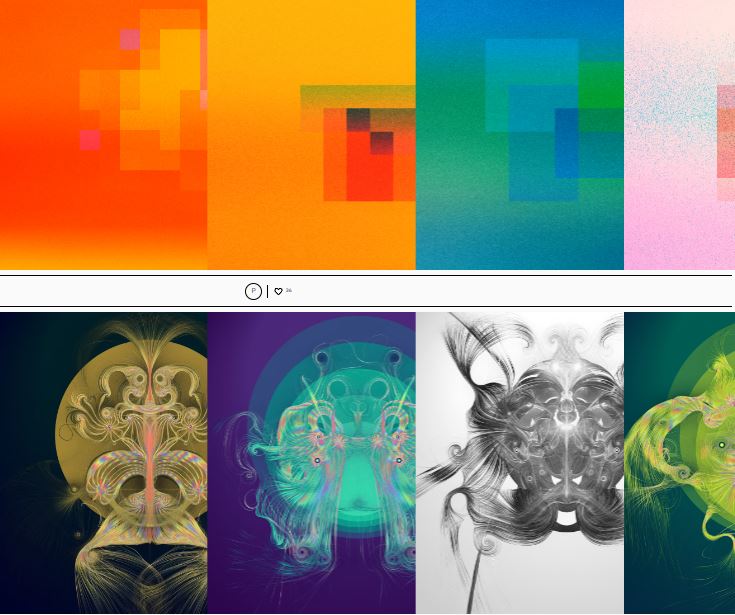[ad_1]
Unlike different NFT collections, Art Blocks is a platform. Its focus is generative or algorithmic artworks. The artists create the model of the gathering, the colours, and kinds, or the “blocks” if you’ll. Each mint kinds by infinite potentialities to create a novel piece. At minting time, the shopper interacts with a generative script and the result’s a randomly generated, unpredictable murals. Depending on the gathering, the ensuing NFT can go from a static picture to a multimedia expertise.
In a lot of the different Blue Chip collections, like World Of Women or Doodles, an artist or a gaggle of artists creates the artwork and its completely different traits. In distinction, a number of artists consistently create Art Blocks collections. As you may think, a few of them are extra precious than others. The platform’s creator is Erick Calderon, higher often known as Snowfro. He’s the artist and coder behind Art Block’s first and flagship assortment, Chromie Squiggle. You’ve in all probability seen them round, and one of many squiggles serves as the emblem for the entire platform.
Other iconic and multi-million greenback collections launched by the platform are Fidenza by Tyler Hobbs and Dmitri Cherniak’s Ringers. Of course, these are the stand-out, extremely profitable ones. New collections and tasks launch by Art Blocks each week, as you’ll be able to see in this very busy calendar. To keep away from gasoline wars at minting time, the platform makes use of the Dutch Auction technique. That is, the sale begins at a excessive worth that lowers as time goes by. The shoppers wait for his or her best worth, if it ever will get there.
How Does Art Blocks Work?
So far, the platform has generated $277M in major gross sales and a whopping $1320M in secondary gross sales. The platform royalties are 10% for major and a pair of.5% for secondary market gross sales. The artist receives a good 5% for every secondary resale. From major gross sales, there’s a compulsory 25% donation to the artist’s favourite charity. Which is attention-grabbing, however wow.
According to Art Block’s website, they provide “genuinely programmable on demand generative content that is stored immutably on the Ethereum Blockchain.” That’s not solely true. The script and the NFTs are there, presumably eternally, however the artwork is just too complicated to be saved on-chain. The information are in IPFS or different storage options.
Art Blocks additionally claims that “collectors actively participate in realizing an artist’s vision by generating unique algorithmic artworks,” which is debatable. The mind-blowing factor is that an Art Blocks holder with entry to the script and Ethereum’s ledger may theoretically reproduce the NFT. So, technically, all the things they declare is true.
Even although Art Blocks is a platform, it’s not open to everybody. A crew curates the collections and selects the artists worthy of taking part. They provide three tiers of collections, every with completely different traits. Let’s look into them.

ETH worth chart for 07/22/2022 on Kraken | Source: ETH/USD on TradingView.com
The Different Collections
- The Curated Collection: This is the principle one, Art Blocks releases it “on a regular schedule.” Only a couple of chosen artists have made it to the seven quarterly series up to now. According to their web site, “Art Blocks established a curation board to carefully select projects for inclusion in our Curated Collection. The Curated Collection is a group of projects that push the boundaries of Generative Art in their technical innovation and aesthetic beauty.”
The firm’s account govt, Druid, expanded on the collections’ traits in a Medium post. “Since we launched Art Blocks in November of 2020, our first official set includes all Curated drops in 2020, with full quarterly sets beginning in 2021. Artists have a six-month cooldown between deploying projects in the Curated Collection.”
- Playground Collection: This one is much less formal, “Art Blocks artists who have been previously included in the Curated Collection” can mess around and do what they need. Druid expands, “It’s important to note the Playground’s limitations: first, an artist can only launch a Playground project after a Curated project. Second, only one project per artist can be active in the Playground at once, and it must be completed before another can be launched on the Playground.” Also, there’s “a two-month cooldown between deploying projects in the Playground Collection.”
- Art Blocks Factory: This is extra common and it’s for artists that don’t essentially have participated in The Curated Collection. According to the web site, “The Factory Collection includes projects selected directly by Art Blocks and highlights our standards for technical quality and artistic beauty.” And based on Druid, “Factory artists will be required to sell out their entire project before releasing anything else on the platform. They also will have a two-month cool down between projects on the platform.”
Powered by Art Blocks (PBAB)
Last however not least, the corporate provides this very interesting product. “Powered by Art Blocks (PBAB) is a custom branded solution from Art Blocks. It allows the generative NFT minting technology used by artists at Art Blocks to be integrated with third-party sites”. That signifies that organizations can use Art Blocks’ “smart contracts and rendering infrastructure” to generate “branded generative projects.”
PBAB might be large sooner or later. Keep your eye on it.
And preserve your eye on NewsBTC for different Blue Chip NFTs guides, like this one for CloneX and this one for Goblintown.
Featured Image: Screenshot from Art Blocks website | Charts by TradingView
[ad_2]
Source link



